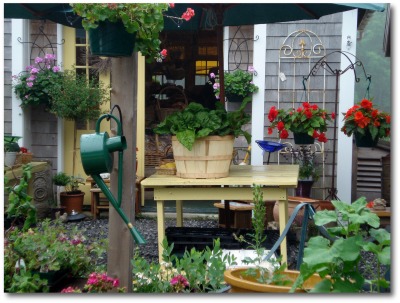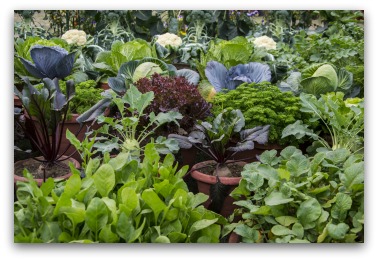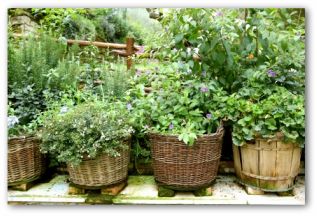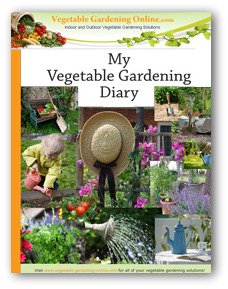Container Vegetable Garden
Plans and Ideas
Try a container vegetable garden plan for small space gardening!
Use these garden plans, design ideas, and pictures to help you get started.
Design Your Own Vegetable Garden Layout Using our Free "Vegetable Garden Planner" Software!
When growing a container garden, any small space can become a potential garden location.
An ideal garden spot receives full sun, has fertile soil, and ample room for the plants to grow.
Container gardens can overcome site limitations by moving the pots to follow the sun's rays.
This vegetables gardening option converts precious little spaces with filtered sunlight into a growing oasis seemingly out of thin air!
1. Choose a sunny location. Full sun is best.
2. Locate near a convenient source of water.
3. Provide fertile, well-drained soil.
4. Plant at proper time; follow planting instructions on seed packet.
5. Keep the weeds out!
Container Gardening Ideas Video
Download Free Garden Planning Worksheets, Garden Diary, Zone Chart, Or Planting Guide
Container Gardens are a Perfect Choice for Small Space Vegetable Gardening
Container garden ideas are ever increasing in popularity with beginners and seasoned gardeners alike.
For people with limited vegetables gardening area or just lack the time for planting a large plot of land, container gardens are a great choice.
Container Garden Plans and Design Ideas
Planting a container herb garden is a good beginning point for those starting out.
Add beauty to your vegetables gardening by choosing decorative cabbages and Brussels spouts.
Attractive options for a container garden are brightly colored yellow, gold, and zebra striped tomatoes.
Designing a Container Garden
There are limitless interesting containers from the huge tire planters to classic Italian or Spanish clay pots.
Convert a rooftop or vacant side-yard into an orderly and productive container garden.
Take full advantage narrow spaces by vertical gardening, using hanging planters, terraces, trellis, and archways.
Follow these Steps to Find Healthy Vegetable Transplants
- Plants with green lush complete foliage, strong stems, and good
root systems will establish quickly. Steer clear of transplants with
yellow, brown, purplish, or white colored leaves.
- Ready to transplant seedlings have two to three true leaves above their seed leaves.
- For
all container sizes except the largest containers, plants should not
have flower buds, immature fruit, or other signs of maturity.
- Select vegetable plants that have not outgrown the original container to avoid choosing root-bound transplants.
- Signs of disease or insect damage may be identified by conspicuous spots or withering leaves.
- Strong healthy plants will appear stocky and dense with healthy green foliage.
- Pass on vegetable container garden plants that appear spindly or weak.
- Be careful not to transport young seedlings from the nursery in hot automobile interiors or trucks. In minutes, tender transplants can be scorched with temperatures of 140 degrees or higher!
Plant Quality Guide for Container Gardens
* Weak spindly foliage is typically caused from inadequate lighting.
* Wilted leaves are usually a sign of insufficient watering.
* Purple leaves develop generally due to a lack of phosphorous.
* Stunted growth ordinarily occurs when the container is not big enough.
Transplanting into Container Gardens
* Select containers large enough to allow roots to fully develop.
* Container vegetable garden plants need more consistent care than their outdoor garden neighbors do.
* Water and fertilizer frequently for best results.
* Fill the pot with sterile potting soil or loose organic compost.
* Avoid dense soils because container plants require good drainage.
* Gently inspect the development and roots of transplant seedling.
* Loosen the rootball by carefully scoring it several times with fork tines to help roots establish in the new container.
* Position the plant in the pot and press the soil down until it is well packed.
* Thoroughly water the transplant.
Keep a Container Vegetable Garden Diary!
Use our Vegetable Gardening Diary to keep records of your container vegetable garden from year to year.
It helps to keep records so that you can remember what worked well, and what not to do again!
Just because the garden is designed on a smaller scale does not mean the yield has to be small sized!
Choose containers for the vegetable garden that compliment your residence and lifestyle.
Whether you live in the big city or a small town, there is nothing tastier than picking fresh grown tomatoes from your own deck or patio!










